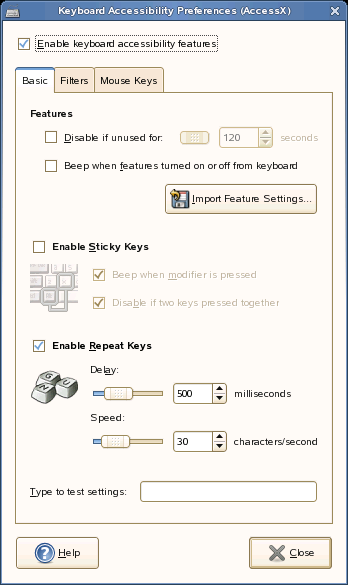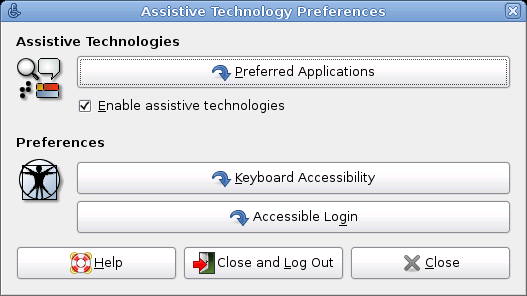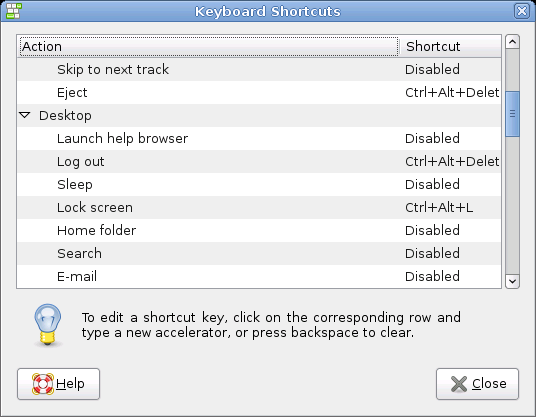2.3 Personal
Personal settings include the following:
2.3.1 Configuring Keyboard Accessibility Settings
GNOME provides keyboard settings designed to help users with motion impairments use the GNOME desktop. Some of the available settings include:
-
How long a key is pressed and held before being recognized as valid input
-
Whether the keyboard can be used as a mouse
-
Whether key combinations that use Alt, Control, and Shift can be duplicated with “sticky keys”
To configure keyboard accessibility settings, click .
The module consists of the three tabs: , , and . Before modifying settings, activate .
Figure 2-33 Keyboard Accessibility Preferences Dialog

Features (Basic Tab)
The keyboard accessibility functions can be deactivated automatically after a certain time. Set an appropriate time limit (measured in seconds) with the slider. The system can additionally provide audible feedback when the keyboard accessibility functions are activated and deactivated.
Enable Sticky Keys (Basic Tab)
Some keyboard shortcuts require that one key (a modifier key) is kept pressed constantly (this applies to Alt, Ctrl, and Shift) while the rest of the shortcut is typed. When sticky keys are used, the system regards those keys as staying pressed after being pressed once. For an audible feedback generated each time a modifier key is pressed, activate when the modifier is pressed. If is selected, the keys do not “stick” anymore when two keys are pressed simultaneously. The system then assumes that the keyboard shortcut has been completely entered.
Enable Repeat Keys (Basic Tab)
Activate to make settings with sliders for and . This determines how long a key must be pressed for the automatic keyboard repeat function to be activated and at what speed the characters are then typed.
Test the effect of the settings in the field at the bottom of the dialog. Select parameters that reflect your normal typing habits.
Enable Slow Keys (Filters Tab)
To prevent accidental typing, set a minimum time limit that a key must be pressed and held before it is recognized as valid input by the system. Also determine whether audible feedback should be provided for keypress events, accepted keypresses, and the rejection of a keypress.
Enable Bounce Keys (Filters Tab)
To prevent double typing, set a minimum time limit for accepting two subsequent keypress events of the same key as the input of two individual characters. If desired, activate audible feedback upon rejection of a keypress event.
Toggle Keys (Filters Tab)
You can request audible feedback from the system when a keycap modifier key is pressed.
Mouse Keys Tab
Activates the keyboard mouse; the mouse pointer is controlled with the arrow keys of the number pad. Use the sliders to set the maximum speed of the mouse pointer, the acceleration time until the maximum speed is reached, and the latency between the pressing of a key and the cursor movement.
2.3.2 Configuring Assistive Technology Support
To configure assistive technology options, click . To enable the technologies, first select and then select the technologies you want to enable every time you log in.
Figure 2-34 Assistive Technology Preferences Dialog

The gok package must be installed in order to get on-screen keyboard support, and the gnopernicus and gnome-mag packages must be installed in order to get screenreading and magnifying capabilities.
If these packages are not installed on your system (they are installed by default during installation), install them with the following procedure:
-
Click .
-
Type the root password, then click .
-
Click .
-
Select from the drop-down menu, then select from the list.
-
Select gok, gnopernicus, and gnome-mag from the list
-
Click .
-
Insert the CD you are prompted for , then click .
-
Click after the package installation is complete.
2.3.3 Changing Your Password
For security reasons, it is a good idea to change your password from time to time. To change your password:
-
Click .
-
Type your old (current) password.
-
Type your new password.
-
Confirm your new password by typing it again, then click .
2.3.4 Customizing Keyboard Shortcuts
A keyboard shortcut is a key or combination of keys that provides an alternative to standard ways of performing an action. You can customize the keyboard shortcuts for a number of actions.
To open the Keyboard Shortcuts tool, click .
Figure 2-35 Keyboard Shortcuts Dialog

To change the shortcut keys for an action, select the action and then press the keys you want to associate with the action. To disable the shortcut keys for an action, click the shortcut for the action, then press Backspace.